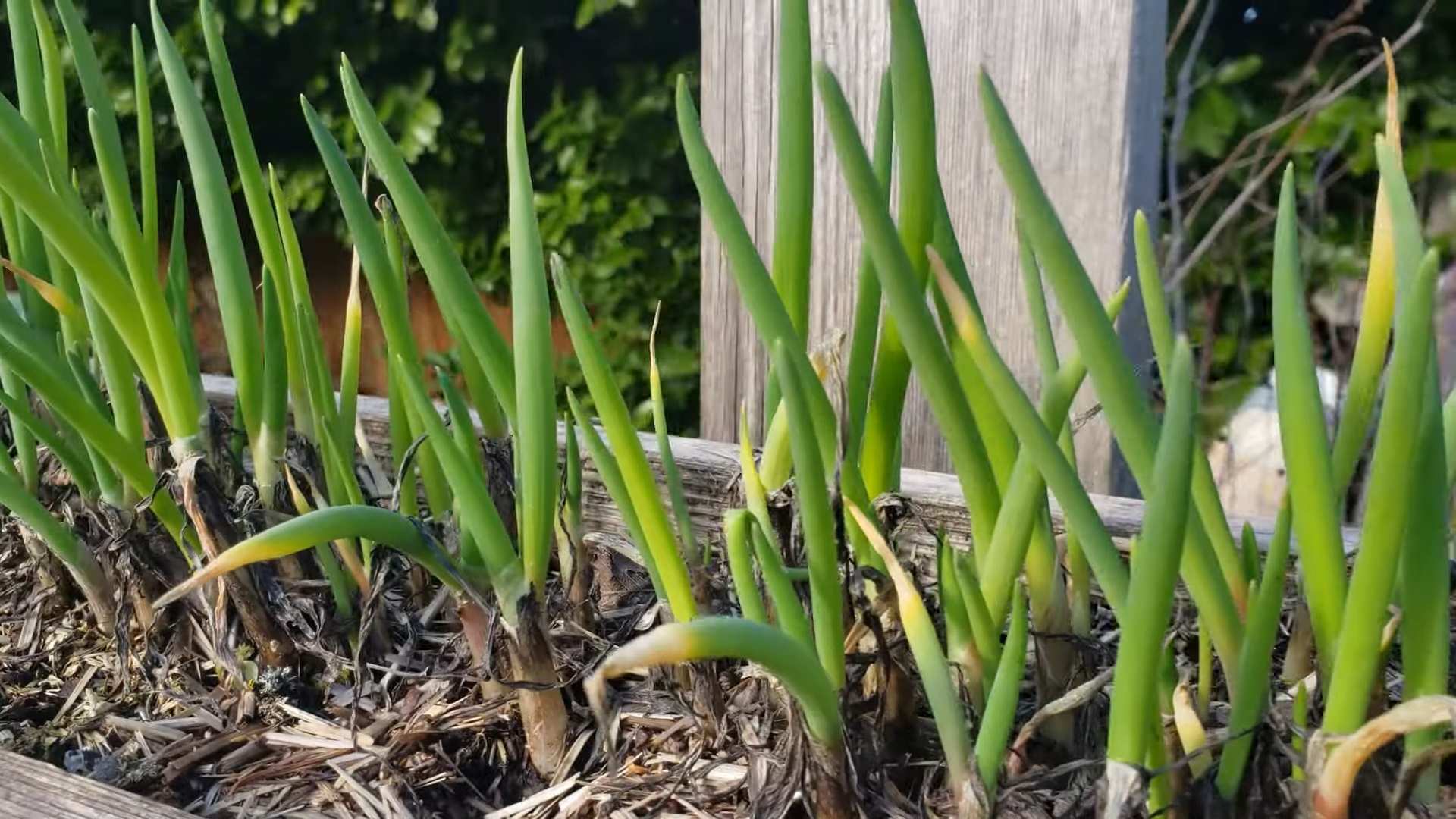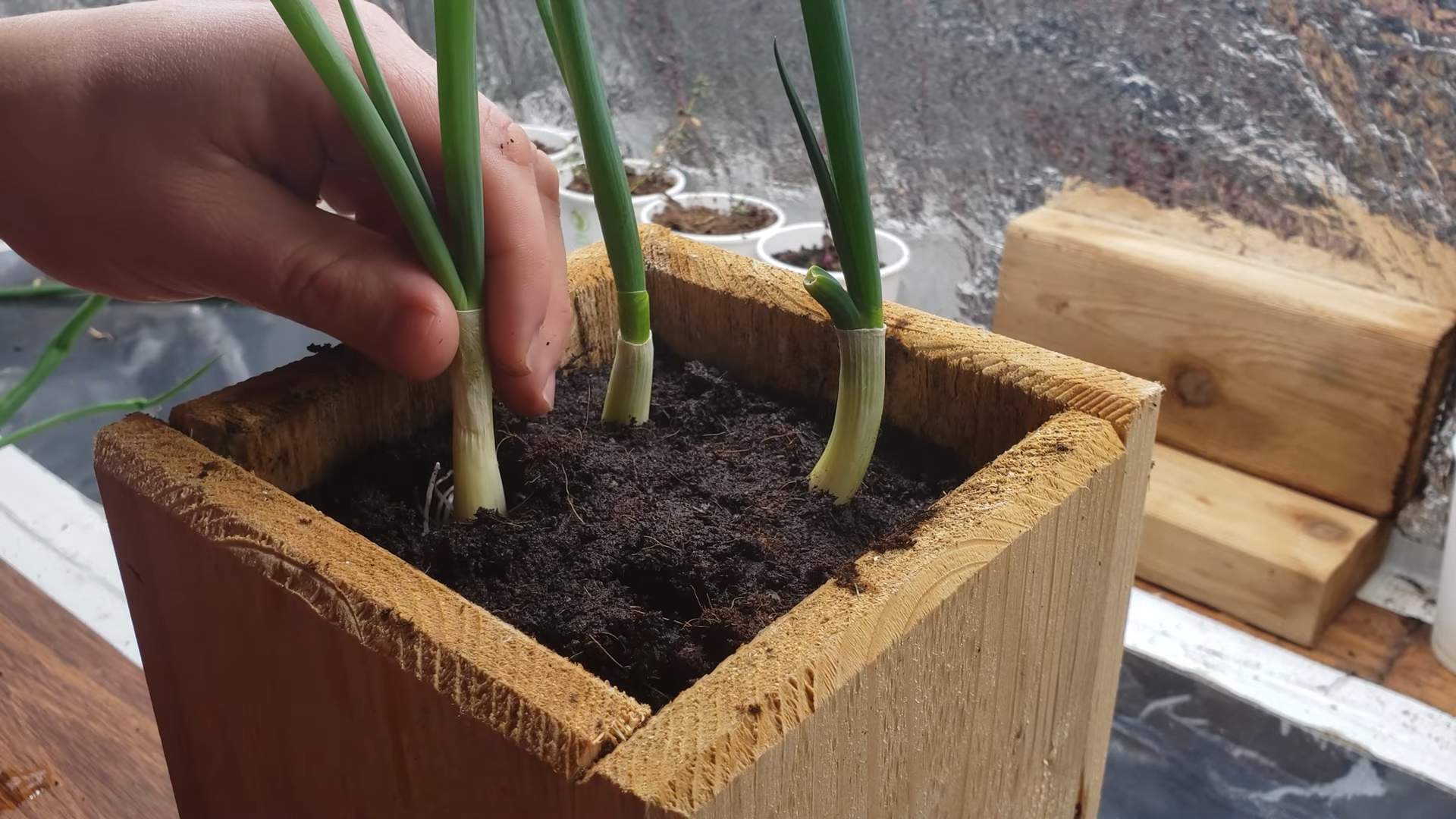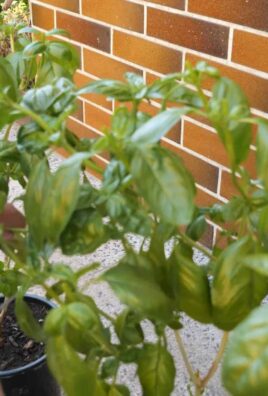Regrow green onions from scraps? Absolutely! Imagine never having to buy green onions again. Sounds like a dream, right? Well, it’s a dream that can easily become your reality with this simple and satisfying DIY project. For generations, resourceful gardeners have been finding ways to extend the life of their produce, and regrowing green onions is one of the easiest and most rewarding ways to do just that.
Think about it: how often do you use just the green parts of your green onions, tossing the white bulb and roots into the compost? What if, instead of composting, you could give those scraps a new lease on life? This isn’t just about saving a few bucks (though that’s definitely a perk!). It’s about connecting with the natural world, reducing food waste, and experiencing the joy of nurturing something from almost nothing. I’m going to show you a super easy trick to regrow green onions from scraps, and trust me, once you start, you’ll be hooked. It’s a fantastic way to add fresh flavor to your meals, and it’s a fun project for gardeners of all skill levels. Let’s get started!

Regrowing Green Onions From Scraps: A Gardener’s Delight!
Hey there, fellow plant enthusiasts! Ever find yourself tossing away the root ends of your green onions after chopping them up for a delicious meal? Well, stop right there! I’m here to tell you that those little scraps are goldmines waiting to happen. You can easily regrow green onions from those discarded pieces, giving you a never-ending supply of fresh, flavorful greens right at your fingertips. It’s super easy, incredibly rewarding, and a fantastic way to reduce food waste. Let’s dive in!
What You’ll Need
Before we get started, let’s gather our supplies. This is a pretty low-key project, so you probably already have most of these things lying around:
* Green onion scraps (the white part with the roots attached)
* A glass or jar
* Water
* Potting soil (optional, for transplanting later)
* A small pot or container (optional, for transplanting later)
* A sunny windowsill or grow light
The Water Propagation Method: Step-by-Step
This is the easiest and quickest way to get your green onions growing again. It’s perfect for beginners and requires minimal effort.
1. Prepare Your Scraps: After using your green onions, cut off the white part, leaving about 1-2 inches from the root end. Make sure the roots are still attached. If the roots are excessively long, you can trim them slightly, but don’t remove them completely.
2. Find a Suitable Container: Grab a glass or jar that’s tall enough to hold the green onion scraps upright. A small mason jar, a drinking glass, or even a repurposed yogurt container will work perfectly.
3. Add Water: Fill the glass with enough water to cover the roots, but not so much that it submerges the entire white part of the onion. You want the cut end to be exposed to air.
4. Place the Scraps in the Water: Carefully place the green onion scraps in the glass, root-end down. Make sure they are standing upright and stable.
5. Find a Sunny Spot: Place the glass on a sunny windowsill or under a grow light. Green onions need plenty of light to thrive. A south-facing window is ideal, but any window that gets at least 6 hours of sunlight per day will work.
6. Change the Water Regularly: This is crucial! Change the water every 1-2 days to prevent bacteria growth and keep the water fresh. This will also provide the green onions with the oxygen they need to grow.
7. Watch Them Grow!: Within a few days, you should start to see new green shoots emerging from the top of the scraps. It’s so exciting to watch them grow!
8. Harvest Your Greens: Once the green shoots are a few inches long, you can start harvesting them. Simply snip off the amount you need with scissors. The green onions will continue to grow back, providing you with a continuous supply of fresh greens.
Transplanting to Soil: For Long-Term Growth
While you can continue to grow your green onions in water indefinitely, transplanting them to soil will provide them with more nutrients and allow them to grow larger and stronger. This is what I prefer to do for a more robust harvest.
1. Choose a Pot: Select a small pot or container with drainage holes. The size of the pot will depend on how many green onion scraps you want to plant together. A 4-6 inch pot is usually sufficient for a few scraps.
2. Prepare the Soil: Fill the pot with a good quality potting soil. You can also add some compost or other organic matter to enrich the soil.
3. Gently Remove the Green Onions from the Water: Carefully remove the green onion scraps from the glass of water. Be gentle to avoid damaging the roots.
4. Plant the Green Onions: Make a small hole in the soil for each green onion scrap. Plant the scraps so that the roots are covered with soil, but the green shoots are still exposed.
5. Water Thoroughly: Water the soil thoroughly after planting. Make sure the water drains out of the drainage holes.
6. Place in a Sunny Location: Place the pot in a sunny location or under a grow light. Green onions need plenty of light to thrive.
7. Water Regularly: Water the soil regularly, keeping it moist but not soggy. Allow the top inch of soil to dry out between waterings.
8. Fertilize (Optional): You can fertilize your green onions every few weeks with a diluted liquid fertilizer. This will help them grow larger and produce more greens. I usually use a balanced fertilizer diluted to half strength.
9. Harvest and Enjoy!: Once the green onions have grown to a desired size, you can start harvesting them. Simply snip off the amount you need with scissors. The green onions will continue to grow back, providing you with a continuous supply of fresh greens.
Troubleshooting Tips
Even with the best intentions, sometimes things don’t go exactly as planned. Here are a few common issues you might encounter and how to fix them:
* Yellowing Leaves: Yellowing leaves can be a sign of overwatering, underwatering, or lack of nutrients. Make sure you are watering properly and consider fertilizing your green onions. Also, ensure they are getting enough sunlight.
* Slow Growth: Slow growth can be caused by insufficient light, poor soil, or lack of nutrients. Make sure your green onions are getting enough sunlight and consider transplanting them to a pot with fresh potting soil. You can also fertilize them to provide them with the nutrients they need.
* Root Rot: Root rot is a fungal disease that can occur if the roots are constantly sitting in water. To prevent root rot, make sure you are changing the water regularly and that the pot has good drainage. If you suspect root rot, remove the affected green onions from the water or soil and discard them.
* Pests: Green onions are generally pest-resistant, but they can occasionally be attacked by aphids or other small insects. If you notice pests on your green onions, you can try spraying them with a mixture of water and dish soap.
Tips for Success
Here are a few extra tips to help you get the most out of your green onion growing adventure:
* Use Fresh Scraps: The fresher the green onion scraps, the better the chances of them regrowing successfully. Try to use scraps that are only a day or two old.
* Choose Healthy Scraps: Select scraps that are firm and have healthy-looking roots. Avoid scraps that are mushy or have discolored roots.
* Provide Adequate Light: Green onions need plenty of light to thrive. If you don’t have a sunny windowsill, consider using a grow light.
* Don’t Overwater: Overwatering can lead to root rot. Make sure the soil is moist but not soggy.
* Harvest Regularly: Harvesting your green onions regularly will encourage them to grow back faster and produce more greens.
* Experiment with Different Varieties: There are many different varieties of green onions, each with its own unique flavor and characteristics. Experiment with different varieties to find your favorites.
Beyond the Basics: Creative Uses for Your Regrown Green Onions
Once you’ve mastered the art of regrowing green onions, you can start experimenting with different ways to use them. Here are a few ideas:
* Garnish: Use your fresh green onions as a garnish for soups, salads, tacos, and other dishes.
* Flavoring: Add chopped green onions to omelets, stir-fries, and other recipes for a burst of flavor.
* Pesto: Make a delicious green onion pesto by blending green onions with olive oil, garlic, Parmesan cheese, and pine nuts.
* Green Onion Oil: Infuse olive oil with green onions for a flavorful cooking oil.
* Composting: If you have any green onion scraps that are not suitable for regrowing, you can add them to your compost pile.
So there you have it! Regrowing green onions from scraps is a simple, rewarding, and sustainable way to add fresh flavor to your meals. Give it a try, and I promise you’ll be amazed at how easy it is to grow your own delicious greens. Happy gardening!

Conclusion
So, there you have it! Regrowing green onions from scraps isn’t just a fun kitchen experiment; it’s a genuinely practical way to reduce food waste, save money, and always have fresh green onions on hand. It’s a small act with a surprisingly big impact, both on your wallet and the environment.
Why is this DIY trick a must-try? Because it’s incredibly easy, requires minimal effort, and yields tangible results in just a matter of days. Forget constantly buying bunches of green onions that inevitably wilt in the crisper drawer. With this method, you’ll have a continuous supply of fresh, flavorful green onions right at your fingertips. Plus, it’s a fantastic way to get kids involved in gardening and teach them about sustainability.
Beyond the basic water propagation method, there are several exciting variations you can explore. Once your green onion roots are well-established in water, consider transplanting them into a pot of soil for even more robust growth. This will allow them to develop larger bulbs and potentially even flower. You can also experiment with different types of containers. While a simple glass jar works perfectly well, you might find that a repurposed plastic bottle or even a decorative planter adds a touch of personality to your kitchen garden.
Another variation involves fertilizing your regrowing green onions. While they can thrive in just water, adding a diluted liquid fertilizer every few weeks can boost their growth and flavor. Look for a balanced fertilizer specifically formulated for vegetables. Remember to dilute it according to the package instructions to avoid burning the roots.
Don’t be afraid to get creative with how you use your homegrown green onions. They’re a versatile ingredient that can add a burst of flavor to countless dishes. Sprinkle them on salads, soups, stir-fries, omelets, tacos, or anything else that could benefit from a fresh, oniony kick. You can even use them to make a delicious green onion pesto or chimichurri sauce.
The possibilities are endless!
We wholeheartedly encourage you to give this DIY trick a try. It’s a simple, rewarding, and sustainable way to enhance your cooking and reduce your environmental footprint. Once you experience the satisfaction of regrowing your own green onions, you’ll wonder why you didn’t start sooner.
And most importantly, we want to hear about your experience! Share your photos, tips, and stories in the comments below. Let us know what variations you’ve tried, what dishes you’ve used your homegrown green onions in, and any challenges you’ve encountered along the way. Together, we can create a community of green onion enthusiasts and inspire others to embrace this simple yet powerful DIY trick. Let’s all work towards reducing food waste and enjoying the freshest possible ingredients, one regrown green onion at a time. This simple method of regrowing green onions is a game changer.
Frequently Asked Questions (FAQ)
How long does it take for green onions to regrow?
Typically, you’ll start to see new growth within a few days of placing the green onion scraps in water. Within a week or two, you should have a noticeable amount of new green shoots. The exact growth rate will depend on factors such as the variety of green onion, the amount of sunlight it receives, and the temperature.
What part of the green onion do I need to regrow it?
You need the white part of the green onion, including the roots (if any are still attached) and about an inch or two of the green stalk. This is the part you typically discard after using the green tops. Make sure to cut the green onions above the root line, leaving the root intact.
Do I need to change the water regularly?
Yes, it’s important to change the water every one to two days. This helps to prevent the water from becoming cloudy or stagnant, which can inhibit growth and potentially lead to rot. Fresh water provides the green onions with the oxygen and nutrients they need to thrive.
How much sunlight do regrowing green onions need?
Green onions need at least 6 hours of sunlight to grow well. Place them near a sunny window where they can receive plenty of natural light. If you don’t have a sunny window, you can supplement with a grow light.
Can I regrow green onions in soil instead of water?
Yes, you can transplant your regrowing green onions into soil once the roots have developed sufficiently in water. This will allow them to grow larger and produce more green onions. Choose a well-draining potting mix and a pot that is at least 6 inches deep.
How often should I water green onions grown in soil?
Water your green onions regularly, keeping the soil consistently moist but not waterlogged. Check the soil moisture by sticking your finger into the soil. If the top inch feels dry, it’s time to water.
Can I use tap water to regrow green onions?
Yes, you can use tap water, but it’s best to let it sit out for 24 hours before using it. This allows any chlorine or other chemicals to evaporate, which can be harmful to the green onions. Filtered water is also a good option.
How many times can I regrow green onions from the same scraps?
You can typically regrow green onions from the same scraps several times, but the growth will eventually slow down. After a few cycles, the scraps may become less productive. At that point, it’s best to start with fresh scraps.
What if my green onions start to turn yellow or brown?
Yellowing or browning leaves can indicate a few different problems. It could be due to overwatering, underwatering, lack of sunlight, or nutrient deficiency. Adjust your watering schedule, move the green onions to a sunnier location, or add a diluted liquid fertilizer to the water.
Can I regrow other types of onions besides green onions?
While this method is most effective for green onions, you can also try it with other types of onions, such as scallions or leeks. However, the results may vary.
Are there any pests or diseases that can affect regrowing green onions?
Green onions are generally resistant to pests and diseases, but they can occasionally be affected by aphids or fungal infections. If you notice any pests, you can try spraying them with insecticidal soap. For fungal infections, ensure good air circulation and avoid overwatering.
Can I eat the green onions that I regrow?
Yes, absolutely! The green onions that you regrow are perfectly safe to eat. They will have the same flavor and texture as store-bought green onions.
What is the best container to use for regrowing green onions?
A small glass jar or cup is ideal for regrowing green onions. Make sure the container is clean and that the green onion scraps can stand upright in the water.
How do I know when to harvest my regrown green onions?
You can harvest your regrown green onions whenever they reach a desired size. Simply snip off the green tops with scissors, leaving about an inch or two of the base intact so that they can continue to regrow.
Is regrowing green onions organic?
If you use organic green onions to begin with and avoid using synthetic fertilizers, then yes, your regrown green onions can be considered organic.
What if my green onions don’t grow roots?
Sometimes, green onions may not grow roots if they are too old or damaged. Try using fresher green onion scraps and ensure that the water is changed regularly. If they still don’t grow roots after a week or two, it’s best to start with new scraps.
Can I regrow green onions indoors year-round?
Yes, you can regrow green onions indoors year-round as long as they receive enough sunlight or artificial light.
Does regrowing green onions smell?
Regrowing green onions typically doesn’t produce a strong odor, especially if you change the water regularly. However, if the water becomes stagnant, it may develop a slight oniony smell.
How does regrowing green onions help the environment?
Regrowing green onions helps the environment by reducing food waste, conserving resources (such as water and energy used in commercial farming), and minimizing the need for transportation and packaging. It’s a small but meaningful step towards a more sustainable lifestyle.




Leave a Comment